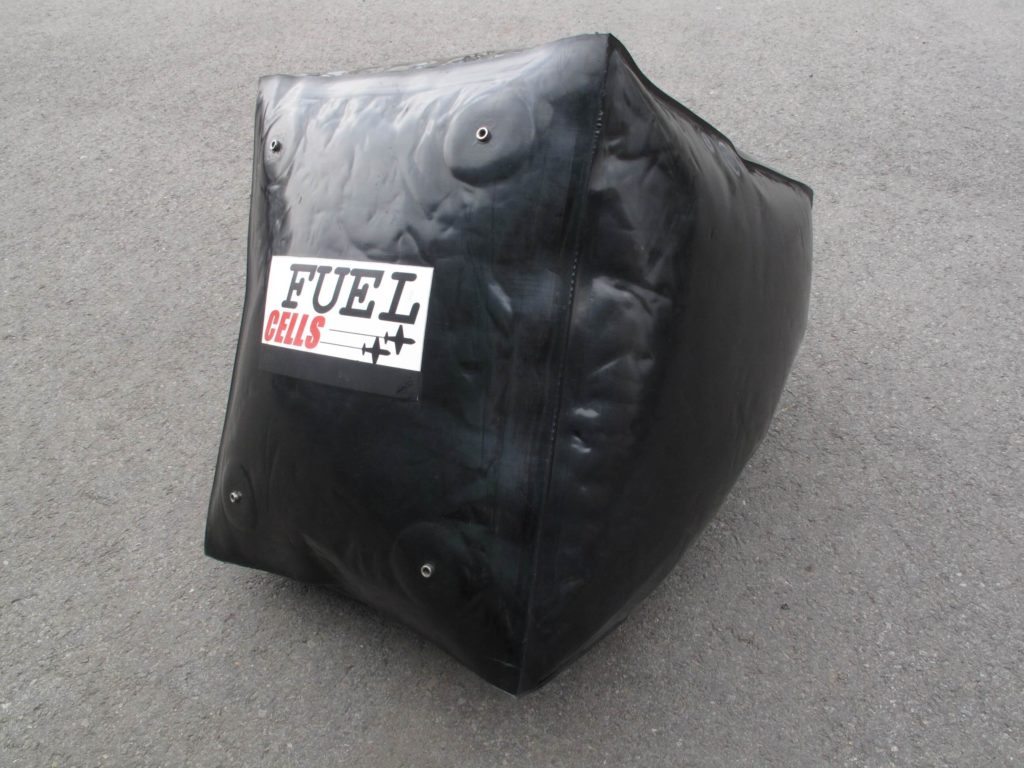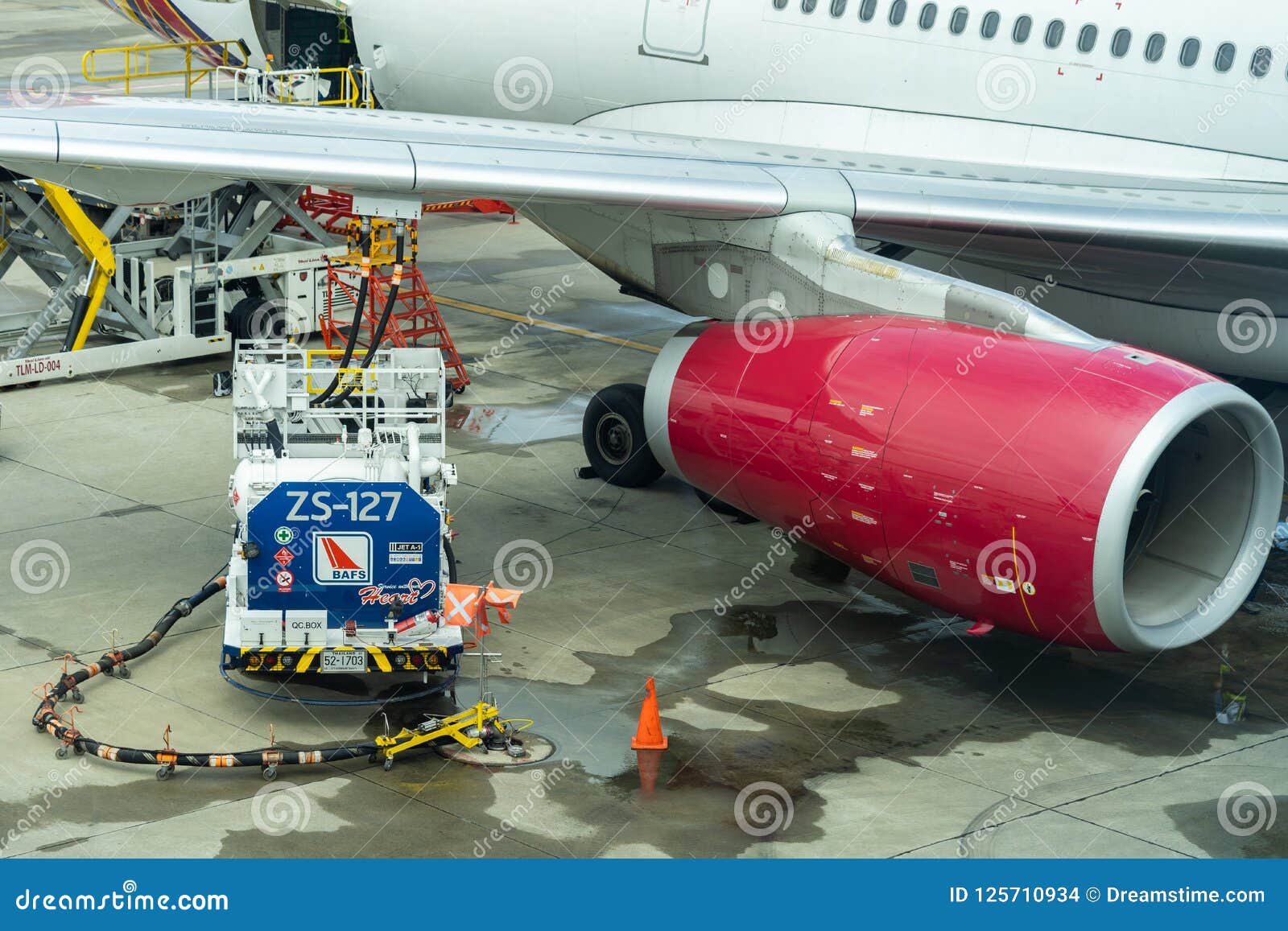Airplane Fuel Tank - An aircraft fuel tank is a major part of an aircraft fuel system. They can be classified as internal or external fuel tanks and further classified by construction method or temporary use. During the investigation into the crash of TWA Flight 800 in 1996, safety aspects of the aircraft's fuel tanks were investigated.
Integrated tanks are areas within the aircraft structure that are permitted to store fuel. An example of this type is the "wet wing" commonly used on large aircraft. Because these tanks are part of the aircraft structure, they cannot be removed for service or inspection. Inspection facilities shall be provided to permit internal inspection, repair and general servicing of the tank. Most major airlines use this system to store fuel in the aircraft's wings, fenders, and exhaust.
Airplane Fuel Tank

Rigid portable tanks are equipped with a section designed to transport the tank. They are usually made of metal, plastic or fiberglass and can be removed for inspection, replacement or repair.
Aircraft Flexible Tank
Rigid portable tanks are not dependent on the structural integrity of the aircraft. These tanks are commonly found in small aircraft, such as the Cessna 172. Fighter jets and helicopters typically use self-sealing fuel tanks.
Bladder tanks, baggage tanks, or fuel tanks are plastic bags installed as part of the aircraft structure and designed to carry fuel. The bladder holder is rolled into the compartment via the fuel filler neck or access plate and is fitted with a quick release or strap and ring inside the compartment. Many light aircraft, helicopters and small turboprops use bladder tanks.
Many aircraft designers have fixed tip tanks on each wing. The weight of the tank and fuel prevents stress on the pedals during maneuvers and reduces fatigue in the spar structure.
A conventional fuel tank (CFT) or "fast pack" is an additional fuel tank tightly attached to the aircraft's main body or continuous airfoil, resulting in reduced aerodynamics compared to external wall tanks.
Aircraft Fuel Tanks
Drop tank, external tank, wing tank, pylon tank, or belly tank are all used to describe externally mounted fuel tanks. Disposable containers are flammable and can often be ignited. External tanks are common on modern aircraft and sometimes on civilian ones, although deployment of the latter is unlikely except in emergencies.
Expendable tanks were originally designed to be dry or jettisoned in combat or emergency situations to reduce drag and weight and increase mobility and range. Modern external tanks may be kept in combat, in emergency situations, and are generally not designed for high flight loads.
Fuel tanks are involved in aviation disasters, causing accidents or worse (fuel tank explosions).

The official explanation for the explosion and subsequent crash of TWA Flight 800 is that a fuel/air explosive device was planted in one of the plane's fuel tanks. A faulty cable caused an ignition source in the tank, destroying the aircraft.
A321xlr's Rear Fuel Tank Demands Special Fire Protection Conditions
While the accuracy of the official results of this incident is still being questioned, there have been similar explosions on other planes. The possibility of a fuel tank explosion can be reduced during access to the fuel tank or tank fire extinguishers.
For example, the Boeing 737 has two systems that reduce the possibility of fuel tank fires. One turns off the fuel pump and the fuel output pressure is low, preventing overheating (since the fuel itself relies on cooling). Another is that the air in the fuel tank is rich in nitrogen, so there isn't enough oxygen to burn it.
Aircraft engines can also be fueled by suction due to stock engine failure, although this is less reliable.
On passenger aircraft, fuel tanks are often integrated into the wings, and wing tanks are preferred if the tank is located inside the fuselage.
Refueling The Plane At The Airport. Gas Tank Hatch. Fuel Tank. Copy Space Stock Photo
Positioning reduces stress on the wing during takeoff and takeoff, putting heavy fuel on the elevator eye.
Placing the tanks on the main wing rather than the tail or nose also reduces the weight outside the fuselage, which changes during flight.
Given their unusual shape and lack of windows, the wings cannot be used for cargo storage or passenger seating. But their hollow structure allows the wing to store fuel properly and make efficient use of space. "Wet shoulder" tanks have a puller to reduce wear.

Wing-mounted fuel tanks also keep passengers and crew away in the event of a rupture or explosion. Trans World Airlines Flight 800 exploded over the Atlantic in 1996, possibly due to an explosion of fuel/air vapors in fuel tanks, possibly from a short circuit. This event has been the driving force behind fuel tank management for the past 19 years. Since 1996, the FAA has issued more than 100 ventilation guidelines and specific Federal Aviation Regulations to minimize ignition sources and reduce tank fires.
Quick And Easy Piper Fuel Tank Repair
A fuel tank vent is a system designed to reduce fires in the central fuel tank of commercial aircraft. The oxygen in the fuel tank is replaced with an inert gas (eg nitrogen). Although military aircraft have used roll-on systems since World War II, the system was considered too complex, heavy, and expensive for commercial aircraft until 2002. Compressible or moving parts. The system installed on the Boeing 747-SP weighs only 200 pounds.
To inspect and replace aircraft fuel tanks, most of the work must be done internally. Workers must be exposed to hazards such as fire, explosions, toxic chemicals and irritants, and lack of oxygen. Safety measures to ensure adequate ventilation such as monitoring and maintenance are mandatory. Aircraft 1
Special fuel and fuel tank requirements must be met when building the SR-71 Blackbird. The aircraft has six large 80,000 lb fuel tanks that can withstand temperatures of up to 200C (400F) and require special fuel with a high flash point to reduce the chance of explosion or fire. All fuel tanks are exposed due to intense thermal expansion and contraction cycles.
Farmers in South Vietnam developed an interesting method of recycling jet fuel tanks after the Vietnam War. The group reclaimed thousands of foreign fuel tanks from American aircraft and built riverboats and boats. The boat was built from a B-52 fuel tank.
Fixed Wing And Rotary Wing Aircraft Fuel Systems
Source: Aircraft Accident Reports - National Transportation Safety Board, FAA Fact Sheet - Fuel Tank Safety, SR-71 Blackbird Ever wondered what happened to the remaining US military aircraft after the Vietnam War? The Dangers of Accessing Aircraft Fuel Tanks - Boeing ... Members Learn More About Safety - Learn More About Becoming A Pilot - Click Here
The King Air series of twin-turbocharged engines have been successful since the first 90-line model was introduced in 1964. Over its 54-year history, there were several design variants, but most shared the same fuel system design. Philosophy. Take the example of the King Air B200 fuel system.
Adjusting the fuel tank is nothing special. Each wing has a large guide, which is actually five interconnected compartments, and holds 386 gallons. There is a 79-gallon, plastic auxiliary bladder (auxiliary) tank located inside the engine bay. Another 57-gallon tank is located behind the engine.

Normally, fuel is first transferred from the auxiliary to the nacelle tank. This creates a challenge: how to transfer fuel from the auxiliary tank to the tank. Here the booster tanks' jet pumps (simple, unidirectional fans with no moving parts) are installed along with two engine-driven pumps (a low-pressure booster pump and a high-pressure engine pump) for each engine. A booster pump (another type of jet pump) draws oil into the oil tank.
Microbial Mitigation Matters More As Fleets Remain Idle
You cannot use a cross to maintain fuel imbalance between wings. This system only has a fuel line that feeds the tank across the engine, not the main or auxiliary tanks. Failure of this auxiliary fuel transfer system can cause fuel starvation. That's why there's a rubber shift warning light on the fuel control panel. Now it's time to switch the Aux Transfer fuel control panel from the normal, automatic position to the Override position. This bypasses the automatic transfer function, opens the flow pump to the manifold and restarts the oil tank.
Of course, if the tank is somehow dry, the moving light will also come out. But before that happens, sensors and internal float gauges
Airplane fuel tank size, fuel tank capacity of airplane, fuel tank of airplane, airplane fuel tank race car, airplane fuel, rc airplane fuel tank fittings, rc airplane fuel tank, airplane fuel tank capacity, airplane fuel tank location, airplane fuel tank sealant, airplane tank, model airplane fuel tank